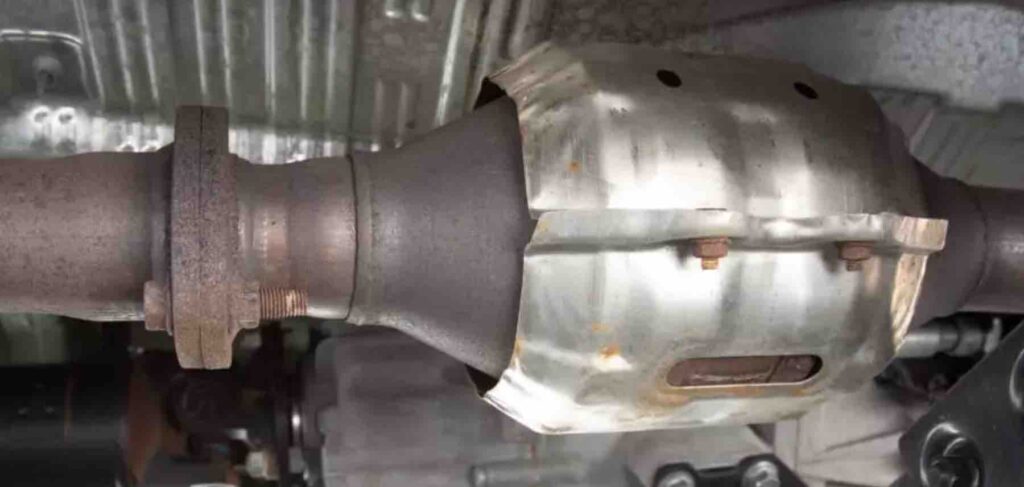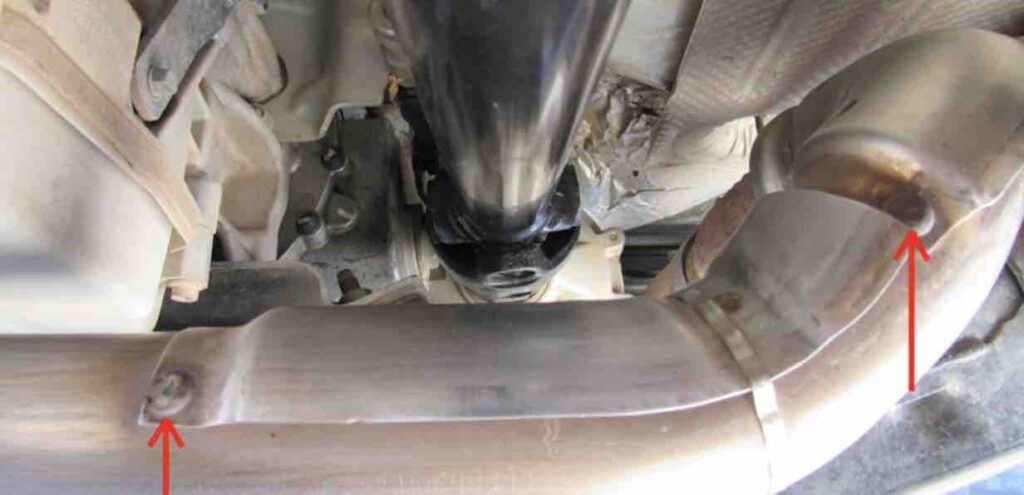If you are looking for a guide on How To Unclog A Catalytic Converter, this post is for you. Driving with a clogged catalytic converter puts unnecessary load and strain on your engine. Additionally, your driving experience will be significantly affected because of the reduced performance of your engine.
You can carry out a simple unclog procedure by:
- Utilize fuel additive options.
- Using a catalytic converter cleaner.
- Detach it from the vehicle and manually clean it out.
With all the dust and carbon that need to be expelled by the catalytic converter, it is only natural that it gets clogged over time. To keep your vehicle in top form and maintain the health of the environment, you need to know how to unclog your catalytic converter.
Continue reading to find out more about how to effectively unclog your catalytic converter.

Can A Catalytic Converter Unclog Itself?
No, the catalytic converter cannot unclog itself. Although the CAT is cleaned out each time it expels fumes, residue carbon deposit will always remain. These remains tend to stack up and clog up your exhaust system. With this insight, we can come to the understanding that this issue cannot solve itself.
Your catalytic converter, like other car parts, will ultimately malfunction or clog. Keep a close eye on your car if you don’t want to incur needless replacement fees, especially due to reasons like waiting for it to ‘unclog’ itself. The easiest approach to prevent problems with your catalytic converter is to drive your car frequently and have it serviced.
How To Unclog A Catalytic Converter
Follow the steps below to learn how to unclog your catalytic converter with a catalytic cleaner. With this method, you can get your CAT cleaned without removing it from your vehicle.
- The first step is to decide on which catalytic cleaner is best for your car. Diesel and gas engines use different converter cleaners.
- Make sure the gas in your car is half full. This is because the catalytic converter a small amount of gas to be cleaned properly.
- Follow the cleaner’s recommended placement in the gas tank by reading the instructions on the container.
- Drive your car around to allow the cleaner to mix properly with the fuel and flow into your exhaust system.
After these steps are completed, you just have to continue driving until the petrol tank is nearly empty. If your check engine light stays on after these steps are completed, visit your mechanic to get it diagnosed and fixed.
Additional tips to Unclog A Catalytic Converter are:
Check your air filter and if it is clogged or bad, then replace it if it is dirty:
The air filter usually is responsible for cleaning the air that gets into your car engine, and when it becomes clogged with dirt or debris, it will restrict the amount of air that will enter the engine of your vehicle leading to poor engine performance. And poor machine performance will lead to a clogged catalytic converter.
Steps to check the air filter:
Check the fuel system for any leaks or problems:
A malfunctioning fuel system can cause the engine to run rich, which means that too much fuel is entering the engine compared to the amount of air. This can cause the catalytic converter to become clogged with carbon build-up. To check for leaks or problems in the fuel system, start by visually inspecting the fuel lines and connections for any signs of leakage or damage. Check the fuel pressure using a fuel pressure gauge. It’s also important to ensure that the fuel injectors are functioning properly. You can check this by using a scan tool to check the fuel injector pulse width and ensure it’s within the specified range.
Use a fuel additive specifically designed to clean catalytic converters:
Fuel additives such as Sea Foam or Cataclean can help break down and remove any built-up carbon or debris in the catalytic converter. These products are poured into the fuel tank and work through the fuel system to clean the converter. They can be found in most auto parts stores and should be used according to the manufacturer’s instructions.
Clogged Catalytic Converter Sound
When your catalytic converter gets clogged, you will hear rattling sounds coming from underneath your car. The catalyst-coated honeycomb meshes on the inside of a catalytic converter. It might collapse or break apart if it becomes old or damaged internally as a result of the catalytic converter being clogged.
In some cases, clogs can even cause the catalyst components to disintegrate. For a simple test, give your cat a tap and listen for rattling sounds if you suspect it has been damaged. If the “honeycomb” part of the catalyst gets too damaged, it could render the converter useless.
Signs of Overheated Catalytic Converter
Dark smoke from your exhaust and the odor of hydrogen sulfide in your gasoline are typical indicators of an overheated converter. When your catalytic converter functions properly without overheating, hydrogen sulfide will be converted to sulfur dioxide, which is odorless.
In essence, look out for a sulfuric, rotten egg-like odor emanating from the exhaust. The stench is caused by the residue of unburned fuel left in the exhaust of a damaged catalytic converter. It is also the reason behind the dark exhaust smoke. In the long run, overheating will cause the converter parts to melt and be damaged.
How To Test Catalytic Converter With Scan Tool
Carrying out tests with a scan tool is simple. With frequent tests, you will be able to stay updated on the condition of your catalytic converter and prevent emission tests from failing.
- Picking a quality tool that is compatible with your vehicle is crucial first step. Select a good OBD2 scanning tool. There are various options on the market.
- Next, your scan tool should be plugged into the OBD-II port on your vehicle. The port can be typically found on the left side of most steering wheels.
- Make sure your vehicle is powered on. This will allow the OBD2 to connect to the onboard computer.
- When your vehicle comes on, let it run for 10 to 15 minutes while you run the test.
- Scan your vehicle with the tool, getting the P0420 error code means there is an issue with your CAT.
How To Test Catalytic Converter With Infrared Thermometer
- First, turn on your vehicle and let it idle for roughly. Allow the engine to operating at normal temperature for 10 – 20 minutes.
- Set your transmission to Park or Neutral and park your car on a level surface.
- To get a better reach of your catalytic converter, lift your car with a floor jack and jack stand.
- Next, get an accurate measurement of the catalytic converters inlet pipe temperature (Preferably from the pipe that joins to the front).
- After that, measure the temperature of the outflow pipe that links to the catalytic converters back.
These sets of data should give you an accurate grasp of the temperature your catalytic converter is operating on. With the result of this step, you will be able to detect overheating issues before it leads to measure issues.
Are Catalytic Converters Effective?
Yes, converter cleaners are very effective. Catalytic converters cleaners function by getting rid of carbon buildup in your exhaust system. It can aid in extending the lifespan of your catalytic converter when it is used for minor issues like clogs or routine maintenance cleaning.
However, converter cleaners have their limitations. They won’t be able to fix a converter failure caused by significant carbon deposits. A cleaner only works best as a prevention tool. Permanent damage caused by factors like overheating cannot be fixed by a cleaner. They cannot reverse or repair components with severe damage.
Conclusion
Dealing with a clogged catalytic converter doesn’t have to be an hassle. In this article, we have covered a fair amount of information that can be of aid to you. Driving with a clogged converter will undermine your cars performance more and more over time. Dealing with it as soon as it is diagnosed is the most efficient way to handing it.
Related Article:
- How Can I Get the Best Price for My Catalytic Converter Scrap?
- What Happens If You Keep Driving With A Bad Catalytic Converter?
- How often & How Much Is It To Replace A Catalytic Converter

Uchenna is a Radiographer and Auto parts mechanic who recently got his automotive diploma as an auto repair technician, and since then, has worked on fixing various car problems.
Working as just a radiographer, Uchenna didn’t just get all the fulfillment he desired, because he truly loved doing things tilted toward cars. As a kid, he would take apart his toy cars to see how they worked and would spend hours tinkering with his bike.
So, in 2017 he made the tough decision to become an auto mechanic. He threw himself into his studies and now loves every aspect of what he does.
He gets to work with his hands, solving problems and bringing cars back to life, and sharing his knowledge and easy quick-fix guide online are all part of what makes him feel fulfilled.


